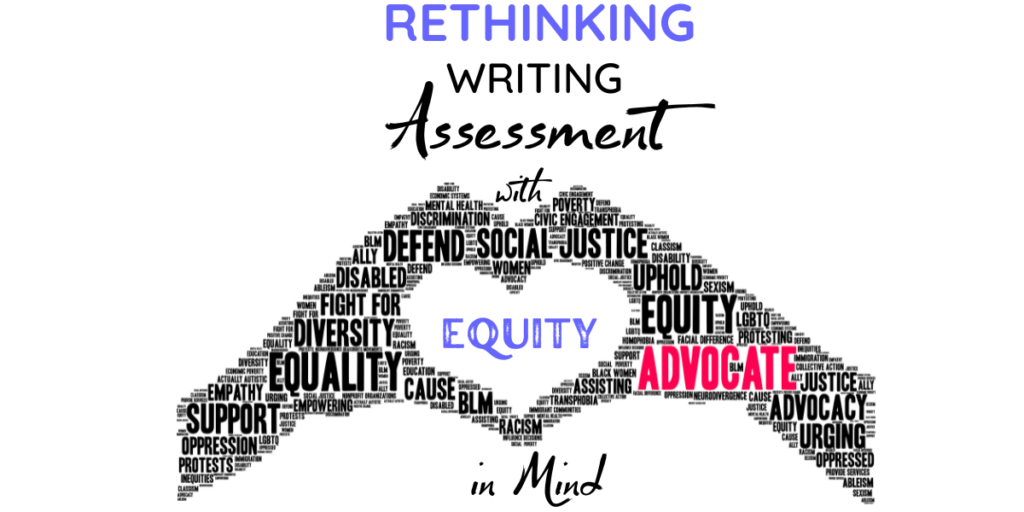
In this six-part series, I outline exactly how I’m rethinking my workshop classroom with an equity lens. You can find the other parts of this series here:
Part 1: Rethinking Writing Workshop with Equity in Mind
Part 2: Rethinking Reading Workshop with Equity in Mind
Part 3: Rethinking Conferencing with Equity in Mind
Part 4: Rethinking Unit Design with Equity in Mind
There are many things I take issue with when it comes to the way we go about grading writing. But, before going into the topic of writing assessment specifically, I want to challenge some of the more general inequitable grading practices that pervade our school systems.
Here is a list of the grading practices I used to follow, and that I’ve started to question as a result of the current social justice movement in education:
- Our school system is centered on letter grades as the only representation of success
- The one-size fits all assessments, such as tests, essays and presentations, that don’t take into account diverse learning abilities and the multitude of other ways students can show they’ve learned
- The way students are often blamed for not doing well on assessments and the teacher seems to have little culpability in the matter, teachers have so much power over students
- The 0-100 scale and uneven distribution of what qualifies as an F (0-50, fifty ways to fail!) and what qualifies as a “good grade” (80-90, only ten ways to do well)
- Grading participation which puts shy students and students with social anxiety at a disadvantage
- Assigning and grading homework which puts students with a lack of home resources at a disadvantage
- Grading soft skills (participation, time management, listening, organization) which puts students with executive function challenges at a disadvantage
*Please note-I believe soft skills are important and should be explicitly taught and discussed with students. Soft skills just shouldn’t count toward a student’s grade in the class. This is because a student’s grade should be an accurate reflection of their skills and and knowledge of the content area of reading and writing not reflective of how well prepared and organized a student is.
- Not allowing revisions or retakes or only allowing students to revise/retake to receive up to a B, but not an A
I take issue with all of this. Do you? Teachers have the power to make change. Starting with changing just one of these practices can make a difference in the lives of your students.
Now, on to writing assessment specifically. Before we start, let’s define terms:
Workshop– a method of teaching that empowers students to become readers and writers in and outside of the classroom. This method of teaching involves a system wherein students work toward publishing pieces of writing and developing identities as readers by choosing the books they are interested in. Workshop also prioritizes developing a supportive community of readers and writers.
Equity-the act of treating people fairly. This is not to be confused with equality which is treating people equally. Our students are all unique and have different needs, so treating them all equally is just not possible, but treating them fairly and with their individual needs in mind is possible.
In part five all about how to rethink writing assessment with equity in mind, I’d like to focus on one big problem that is at the root of a lot of other problems and that is implicit bias when grading writing. This issue is a huge elephant in the room when it comes to assessing writing. But, what is implicit bias? Read on to learn more.
The One Big Problem
Implicit Bias and Lack Awareness About How it Impacts Our Grading
What is Implicit Bias?
Implicit bias is a form of bias that occurs automatically and unintentionally, that nevertheless affects judgments, decisions, and behaviors. –National Institutes of Health
Have you ever found yourself thinking about the student behind the writing while grading?
You might have thought things like, this student works so hard or this student goofed off during my lessons or this student was so resistant to any feedback I gave during conferring sessions. These thoughts about students impact how we grade them and it’s time to stop denying that it does.
Favoring some students because they work hard and not others because they goofed off is an example of implicit bias.
We can’t deny that grading writing is inherently subjective. There is not one correct answer we can point to, like in math, there are millions of ways to approach writing and often when a student writes with personality, they are marked down for not writing in a more formal, academic way, when the teacher didn’t even teach what that means or how to do it!
So how can we make grading writing more fair and equitable? How can we overcome our implicit biases when grading writing? Here’s a possible step by step solution to this impactful problem.
A Step-by-Step Solution
1. Bring Awareness to Your Implicit Biases
If you believe you are infallible and bias-free when it comes to grading, you are living in a fantasy world. We must develop a mindfulness practice that allows us to take notice of the thoughts that pop up, seemingly out of nowhere, about students.
The most insidious thought I tend to have is when I label a student as a hard worker or as lazy.
When these thoughts pop up, I immediately take notice and work toward shifting my thinking to more helpful, less genralized labeling. I might shift my thought about a student being a hard worker to, this student has really found their groove when it comes to this skill or subject area. I might shift my thought about a student being lazy to, this student is having a hard time getting into this skill/subject, or they may be prioritizing other things right now.
It is vital we take notice of when we label, categorize and generalize about students. If we don’t take notice, then we can’t take action to shift our thinking to less bias more equitable teaching practices.
2. Only Grade What You Explicitly Taught (and Taught Well)
We must be systematic in the way we teach skills to students and only grade what we systematically taught. Too often teachers expect students to know certain skills already, because, “They are in 6th grade, they should have learned this in elementary school!”.
The truth is, they may have been exposed to writing complete sentences and paragraphs in elementary school, but for some reason or another they did not retain that learning and it’s our job to circle back to these skills. It’s really pretty simple, if you didn’t explicitly teach it, then you shouldn’t grade it.
If you want students to be able to write a complete sentence and use paragraphs, then explicitly teach these skills.
3. Grade with a Well Used, Well Known, Kid Friendly Rubric
Single-point rubrics have been so helpful when it comes to creating kid-friendly rubrics. Rubrics with too much print and text are not kid-friendly. In addition, we must print these rubrics and give them to students at the beginning of our units and have students take these rubrics out during every single lesson.
We need to refer to the rubric as we teach students.
We need to refer to the rubrics as we confer.
We need students to use language from the rubric as they talk about their writing with you and their peers.
If you are looking for easy to use, kid friendly assessment tools (that are editable), then look no further…


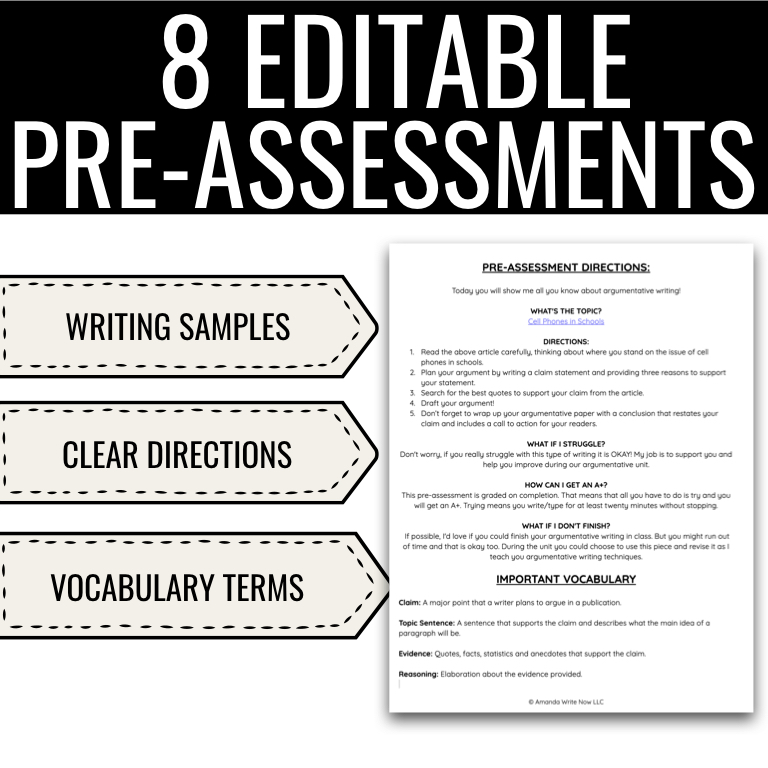
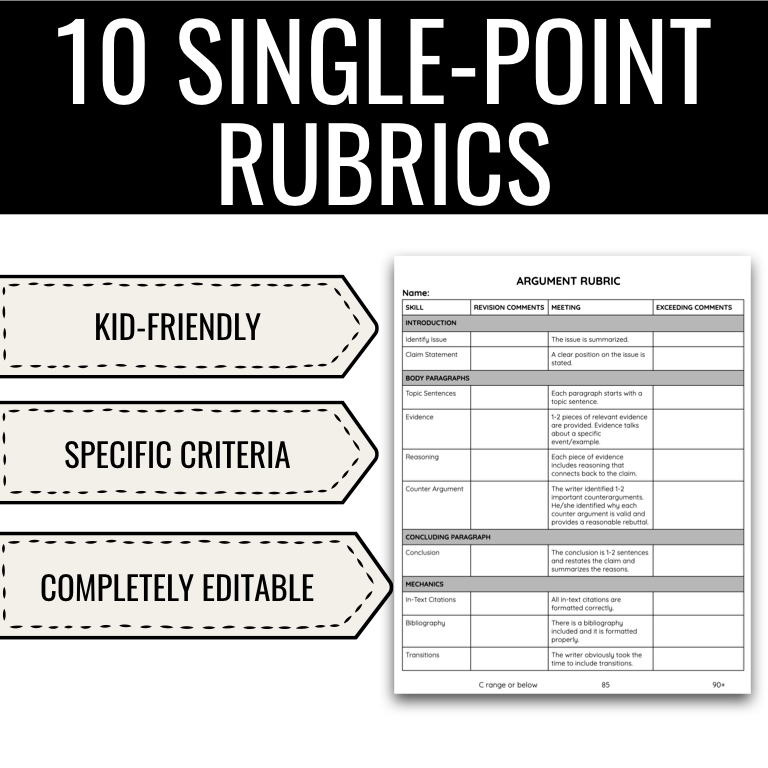
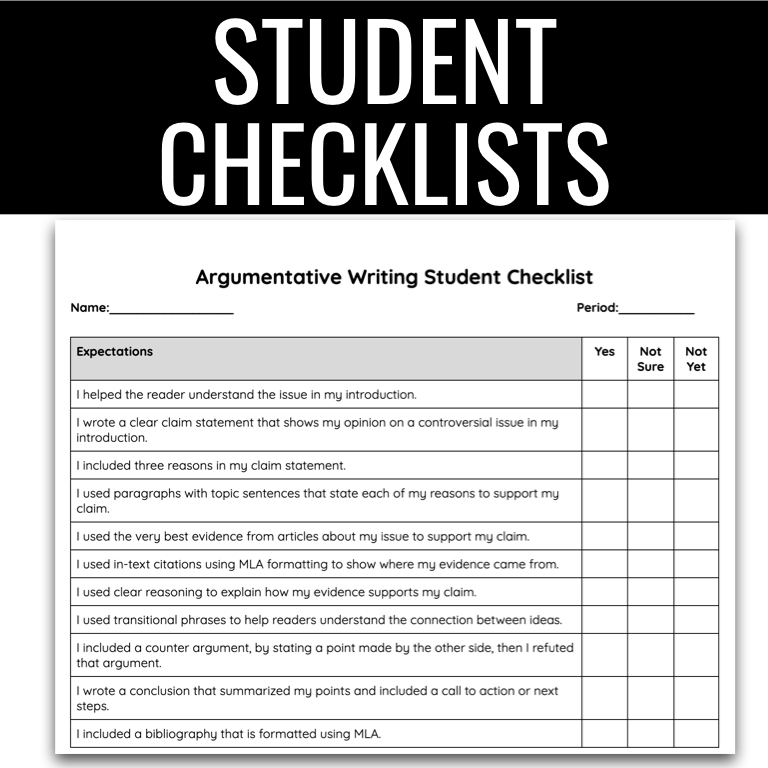
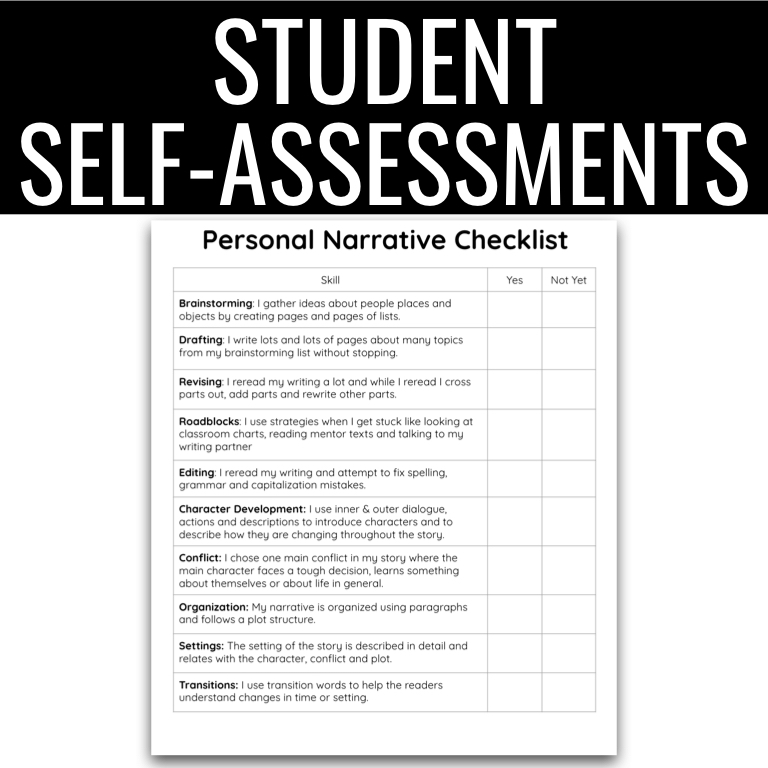

Previous
Next
4. Only Grade 1-3 Standards/Skills from Your Rubric, Don’t Grade Everything
When a teacher is exhausted from grading and just wants to get it over with, subjectivity increases. This is why we need to be laser-focused on 2-3 skills when grading.
This doesn’t mean that you can’t teach more skills, it just means that you are only assessing the skills you notice the majority of your students have deficits in at the beginning of your unit when they do their on-demand pre-assessment.
If you notice many students aren’t writing with paragraphs or complete sentences, then teach those skills multiple times throughout your unit, and really focus on them.
By all means, teach other skills too, but only assess the skills you really drilled in on and students struggled with at the beginning of your unit.
5. Allow Students to Self-Assess
Getting student input is never a bad idea. Have students use the rubric to assess how they feel they did, before handing their rubric and writing piece into you.
Every time I’ve done this I’ve noticed one of two things, students are very hard on themselves or they are extremely accurate in their assessment of their own writing. It is a rare scenario to see a student assess their own writing too highly.
Self-assessments can help you gauge how well your assessment lines up with a student’s. I assess first and afterward, review what they have to say in their self-assessment. It’s often refreshing and affirming to see how well our assessments line up.
6. Allow Revision for Full Credit
Too many teachers only allow students to revise for a B, no more.
Why? Do we assume a student who received a C is not capable of receiving a A?
Or are we just penalizing students for not getting an A the first time?
We need to not only allow students to revise but also, allow students to receive full credit for their revisions.
7. Give Students Tools, Resources, and Time for Editing and Revision
Many teachers, because of a lack of time, provide students with the rubric, their comments, and grade and expect students to be able to find the tools, resources and time to revise on their own.
This is not fair.
After a writing unit and students have received their grades, we move on.
This is such a huge missed opportunity for learning. And hey, what about growth mindset? What about being able to learn from our mistakes?
We tout these ideas in our schools with pretty displays on our bulletin boards, TedTalks, and school assemblies, but where’s the actual practice of these beliefs in our classrooms? Do your students a favor and stop the hypocrisy by giving students a full week (or more if they need it) to revise.
Make time to provide students with the remedial mini-lessons, videos, charts, and tools they need to revise during this week. Teachers may wonder, but what about the students who received As or Bs and don’t want to revise? Make them. It won’t hurt a student who received an A or B to receive extra instruction with revision. All writing can be improved, even A+ writing.
Check out this YouTube Playlist with remedial mini lessons for writers:
8. Get Student Feedback on Your Lessons/Grading Practices
After a unit, it’s a great idea to get your students’ feedback. Ask them directly in a Google Form, how fair do you feel you were treated during this unit? How fair do you feel you were assessed? How well do you feel you were taught________________skill? What extra supports do you feel you needed? Student input is invaluable and can inform the actions we take in the next unit.
Wrap Up
There are so many problems with our grading practices, it can feel overwhelming and cause teachers to give up and continue on with what has been done before. This is a huge mistake because there are very specific and practical things individual teachers can do to improve their grading practices and promote equity.
Even if you only choose one thing from the list of changes you can make, you are going to make a difference in the lives of your students. If you do only pick one thing this year, I recommend picking #1: bring awareness to your implicit biases.
We must do this before all else. What assumptions are you making about your student(s)? If you are uncomfortable speaking about it, then journal about it, or recognize the biases I’ve stated in this blog post that I’ve had about students. Start there. When are you assuming a student is lazy? When you notice this thought pop up, label it what it is, bias, and move onto to a less bias generalization. Look at students as individuals rather than categorizing them in this way.
This is the beginning of a long journey, so don’t beat yourself up about it either. That does more harm than good anyways. Most importantly though, remember that there are others on this journey with you. There are other teachers in the world who care deeply about making changes for social justice. When we can remember those teachers, the solidarity can be invigorating. I’m with you social justice warriors, let’s go make some changes today! Feel free to comment below with some changes you plan to make this year. I’d love to hear from you.
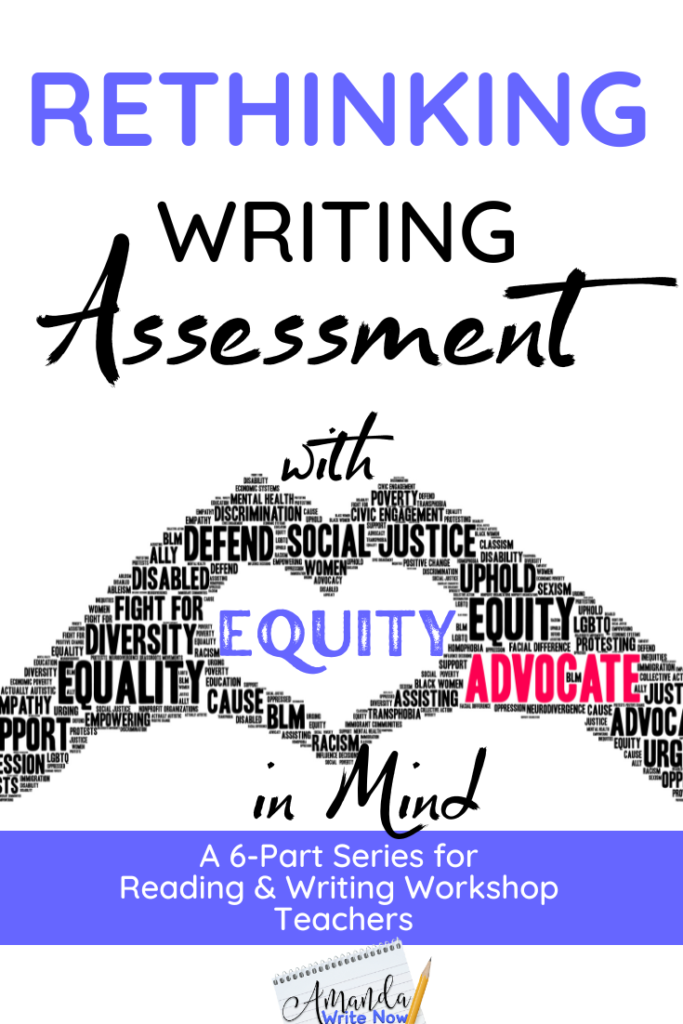



0 Comments